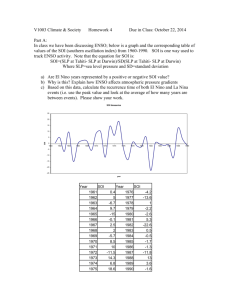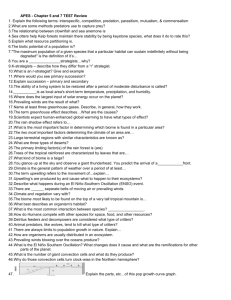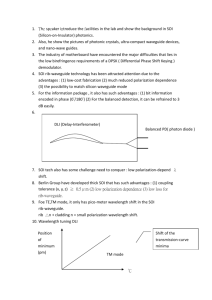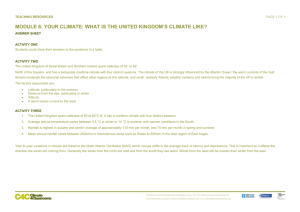V1003 Science & Society - Earth and Environmental Sciences
advertisement
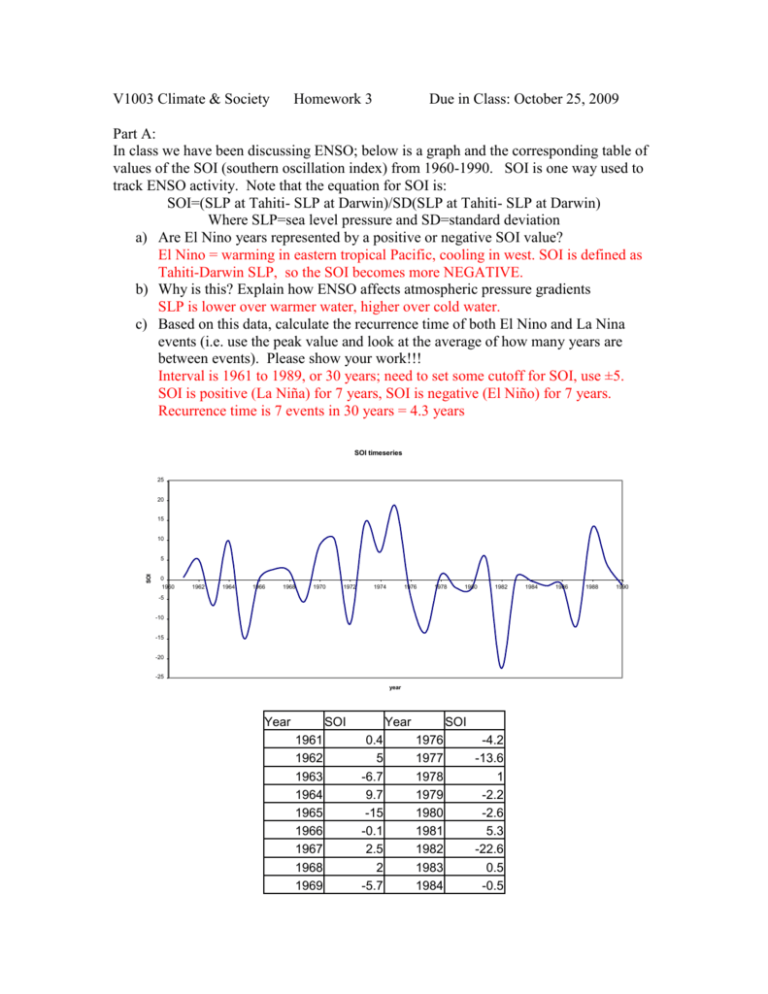
V1003 Climate & Society Homework 3 Due in Class: October 25, 2009 Part A: In class we have been discussing ENSO; below is a graph and the corresponding table of values of the SOI (southern oscillation index) from 1960-1990. SOI is one way used to track ENSO activity. Note that the equation for SOI is: SOI=(SLP at Tahiti- SLP at Darwin)/SD(SLP at Tahiti- SLP at Darwin) Where SLP=sea level pressure and SD=standard deviation a) Are El Nino years represented by a positive or negative SOI value? El Nino = warming in eastern tropical Pacific, cooling in west. SOI is defined as Tahiti-Darwin SLP, so the SOI becomes more NEGATIVE. b) Why is this? Explain how ENSO affects atmospheric pressure gradients SLP is lower over warmer water, higher over cold water. c) Based on this data, calculate the recurrence time of both El Nino and La Nina events (i.e. use the peak value and look at the average of how many years are between events). Please show your work!!! Interval is 1961 to 1989, or 30 years; need to set some cutoff for SOI, use ±5. SOI is positive (La Niña) for 7 years, SOI is negative (El Niño) for 7 years. Recurrence time is 7 events in 30 years = 4.3 years SOI timeseries 25 20 15 10 SOI 5 0 1960 1962 1964 1966 1968 1970 1972 1974 1976 1978 1980 1982 -5 -10 -15 -20 -25 year Year SOI 1961 1962 1963 1964 1965 1966 1967 1968 1969 Year 0.4 5 -6.7 9.7 -15 -0.1 2.5 2 -5.7 SOI 1976 1977 1978 1979 1980 1981 1982 1983 1984 -4.2 -13.6 1 -2.2 -2.6 5.3 -22.6 0.5 -0.5 1984 1986 1988 1990 1970 1971 1972 1973 1974 1975 8.5 10 -11.5 14.3 6.8 18.6 1985 1986 1987 1988 1989 1990 -1.7 -1.3 -11.8 13 3.6 -1.6 Part B: 1) Imagine you are a fisherman in Peru and a La Niña is forecast to begin this fall and into early next year (as it is!). a) Should you expect a prosperous year; why or why not? (2 sentences or less) Yes is should be a high upwelling, high productivity year (we didn’t discuss this in class but it is in the readings). Stronger winds = more upwelling, more productivity b) How would your outlook differ if it were an El Niño year and why? (2 sentences or less). Weaker upwelling/productivity due to weaker winds. c) Draw a sketch of the Pacific Ocean as you expect it to be in December 2010, indicating the ocean temperature gradients (where it is warm/cold), the Walker circulation, where convection/rain occurs and where it is dry, the thermocline slope, sea surface height, trade winds (are they stronger or weaker than normal?), and upwelling (same). La Niña 2) Imagine Aqua-World – a world with no land surface anywhere, but a planet the same size a rotation rate as Earth. a) Would there be trade winds? Why/why not? Yes, because planet rotates, unevenly heated b) Would there be upwelling? Why/why not? Yes, on the equator, because the winds will cause surface water divergence and upwelling…all around the equator. c) Would there be Walker circulation? Why/why not? Probably not, because no one place is warmer or cooler than another so no SST gradient on equator, so no Walker circ. d) Would there be an ENSO oscillation? Why/why not? Probably not, because there is no SST gradient or change in sea surface slope or thermocline slope. Uniform around the equator. e) Now imagine there are maybe 100 tiny little islands just a kilometer in diameter scattered throughout the tropics. Would you expect large year-toyear rainfall variability in these islands? Why/why not? No – if no ENSO, no (large) rainfall variability. Yes there would be seasons though. f) Sketch this world showing trade winds, upwelling, and where the rain fall occurs. (blue = winds, red = surf water, green is upwelling. Rainfall is either over the green, (more accurately) two narrowm bands on either side of the green. 3) Now imagine Wall-World, which is the same as Aqua-World except that it has a huge narrow landmass (say, 100 km wide, see black bar on figure below), Walldonia, that runs North-South crossing the equator. 4) a) Would there be trade winds? Why/why not? Yes. b) Would there be upwelling? Why/why not? Wher?e Yes, but only off the west coast of Walldonia. c) Would there be Walker circulation? Why/why not? Yes, because there is now an SST gradient d) Would there be an ENSO oscillation? Why/why not? Yes, because there is now an SST gradient and a BIG basin. e) Sketch this world showing trade winds, upwelling, and where the rainfall occurs. (blue = winds, red = surf water, green is upwelling. Rainfall is either over the green, (more accurately) two narrowm bands on either side of the green. 5) Now imagine that you are the Climate Prediction Specialist for Walldonia. a) The citizens there want to know if their rainfall will be constant year to year or if it will vary. What do you tell them. Will be quite variable – mega-ESO because of the large size of the “Pacific” ocean in Wall World. b) Now they want you to tell them whether the interannual (that is, year to year) rainfall variability at Walldonia will be longer or shorter period that the 4 year average ENSO period on Earth. What do you tell them? Will be longer period recurrence times – mega-ESO because of the large size of the “Pacific” ocean in Wall World. I’d say 6-8 year ENSO cyling. c) Imagine now that you could put weather FOUR stations anywhere on Walldonia to measure and (automatically report back) sea level pressure and ocean temperature at that station. Where would you put the stations and why? I’d put them in the places where you’d get the largest SST and SLP gradients, so east and west of Walldonia and in the middle of the equatorial oceans (see yellow circles above) d) What would these stations tell you that would be helpful for climate prediction in Walldonia? They’d give you SST and SLP and winds, and these can be used for ESNO climate predictions.
